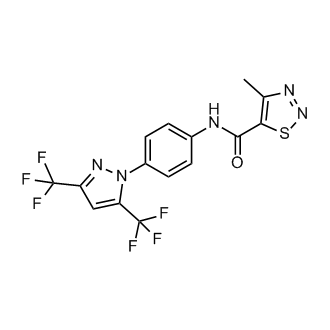| Size | Price | Stock |
|---|---|---|
| 2mg | $55 | In-stock |
| 5mg | $88 | In-stock |
| 10mg | $154 | In-stock |
| 25mg | $319 | In-stock |
| 50mg | $545 | In-stock |
| 100mg | $908 | In-stock |
| 200 mg | Get quote | |
| 500 mg | Get quote | |
| We match the lowest price on market. | ||
We offer a substantial discount on larger orders, please inquire via [email protected]
or Fax: (86)21-58955996
Inquiry for price and availability only. Please place your order via our email or fax.
| Cat. No. : | HY-100831 |
| M.Wt: | 421.32 |
| Formula: | C15H9F6N5OS |
| Purity: | >98 % |
| Solubility: | DMSO : 125 mg/mL (296.69 mM; Need ultrasonic) |
YM-58483 (BTP2) is the first selective and potent inhibitor of CRAC channels and subsequent Ca2+ signals[1]. YM-584832 is a blocker of store-operated Ca2+ entry (SOCE)[2]. In Vitro: YM-58483 can decrease the levels of P-ERK and P-CREB, without affecting the expression of CD11b and GFAP. YM-58483 also inhibits the release of spinal cord IL-1β, TNF-α, and PGE2[1]. YM-58483 and cyclosporine A inhibits T cell proliferation in a one-way mixed lymphocyte reaction (mLR) with IC50 values of 330 and 12.7 nM, respectively[2]. YM-58483 inhibits DNP antigen-induced histamine release from and leukotrienes (LTs) production in IgE-primed RBL-2H3 cells, a rat basophilic leukemia cell line, with IC50 values of 460 and 310 nM, respectively. YM-58483 also inhibits phytohemagglutinin-P (PHA)-stimulated IL-5 and IL-13 production in human peripheral blood cells with IC50 values of 125 and 148 nM, respectively, which is approximately 5 times less potent than prednisolone[3]. YM-58483 inhibits IL-4 and IL-5 production in a conalbumine-stimulated murine Th2 T cell clone (D10.G4.1), and IL-5 production in phytohemagglutinin-stimulated human whole blood cells with IC50 values comparable to those reported for its CRAC channel inhibition (around 100 nM)[4]. In Vivo: Intrathecal YM-58483 at the concentration of 300 μM (1.5 nmol) and 1000 μM (10 nmol) produces a significant central analgesic effect on the SNL rats[1]. In the mouse graft-versus-host disease (GVHD) model, YM-58483 (1-30 mg/kg, p.o.) and cyclosporine A (1-30 mg/kg, p.o.) inhibit donor anti-host cytotoxic T lymphocyte (CTL) activity and IFN-γ production, and also reduce the number of donor T cells, especially donor CD8+ T cells, in the spleen. YM-58483 (1-10 mg/kg, p.o.) and cyclosporine A (2, 10 mg/kg, p.o.) inhibit the sheep red blood cell (SRBC)-induced delayed type hypersensitivity (DTH) response[2]. M-58483 (30 mg/kg, p.o.) significantly suppresses ovalbumin (OVA)-induced bronchoconstriction in OVA-sensitized guinea pigs, whereas prednisolone does not. YM-58483 (3-30 mg/kg, p.o.) and prednisolone (100 mg/kg, p.o.) both significantly and completely suppress airway hyperresponsiveness (AHR) caused by OVA exposure[3]. YM-58483 inhibits antigen-induced eosinophil infiltration into airways, and decreases IL-4 and cysteinyl-leukotrienes content in inflammatory airways induced in actively sensitized Brown Norway rats. Orally administered YM-58483 prevents antigen-induced late phase asthmatic broncoconstriction and eosinophil infiltration in actively sensitized guinea pigs[4].
Lorem ipsum dolor sit amet, consectetur adipisicing elit. Autem earum hic iste maiores, nam neque rem suscipit. Adipisci consequatur error exercitationem fugit ipsam optio qui, quibusdam repellendus sed vero! Debitis.
Inquiry Information- Product Name:
- YM-58483
- Cat. No.:
- HY-100831
- Quantity:


Your information is safe with us.